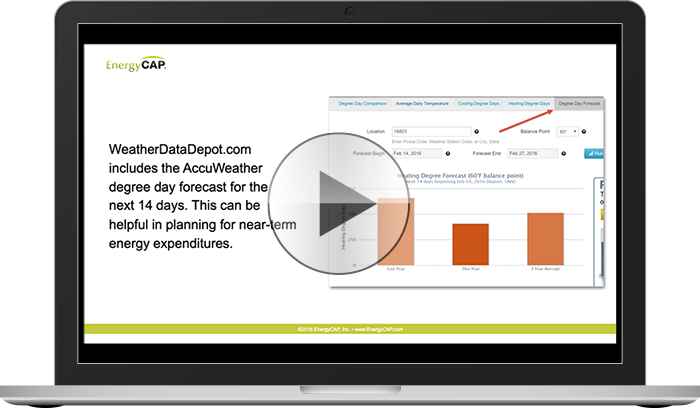 It was spring break for Penn State students here in State College, PA, last week, but our team was hard at work producing a new webinar, How AccuWeather Data Provides Value to Energy Managers.
It was spring break for Penn State students here in State College, PA, last week, but our team was hard at work producing a new webinar, How AccuWeather Data Provides Value to Energy Managers.
Our CEO, Steve Heinz, teamed up with AccuWeather’s Director of Business Development Lou Seidel, to discuss how you can get the most up-to-date and accurate weather data, and turn that information into savings for the energy management program at your organization.
In today’s blog we’ll share highlights, along with the link to the recorded webinar, which provides an interesting behind-the-scenes tour of the processes AccuWeather meteorologists use to acquire and validate weather data.
But raw data isn’t useful to energy managers without a platform, so five value streams – including budgeting, normalizations and M&V (measurement and verification) – are illustrated using EnergyCAP utility bill management software and WeatherDataDepot.com.
EnergyCAP has been partnering with AccuWeather for more than 25 years now. Back in the 1990s, our company used to get daily degree day data from AccuWeather every month on a floppy disk, and then mail copies to clients who would process that weather data along with their monthly utility bills. Those were the days, when big data needed to be lean enough to fit on a floppy!
In the webinar, Steve speculated that the smart building of the future may use more granular weather forecasting data to better manage building controls and fine-tune adjustments based on minute-by-minute weather patterns.
Today, EnergyCAP shares highly-accurate AccuWeather-provided degree day data at a free website, www.weatherdatadepot.com. The site is updated daily, and includes a historical database dating back to 1995 for 14,000+ US and Canada locations. It is possible to compare heating or cooling degree day data for any two calendar years for the location of your choice.
To use weather data for energy management, it is helpful to determine the summer and winter weather sensitivity of each meter. Using AccuWeather data, EnergyCAP software performs this calculation automatically. A linear regression model is used to map energy use (dependent variable) with the known weather severity in degree days (independent variable). By normalizing your energy data for weather, it becomes possible to do yearly weather performance comparisons to see if energy management initiatives are having an impact, and to quantify that impact much more reliably.
When weather impact has been quantified, and historical weather trend information is readily accessible, the energy manager is in a far better position to provide accurate meter-by-meter budgets. It also is possible to generate more reliable measurement & verification reports. Audits can be modified to account for weather changes, reducing false alarms and the wasted time that accompanies them. Finally, more timely weather reporting and forecasting can dramatically improve the accuracy of accrual processes, giving a more accurate assessment of an organization’s fiscal status, present and future.
Steve discusses each of these value streams in detail in the recorded webinar. We encourage you to view it if you haven’t already!
{{cta(‘d0c1c8fb-1578-420c-a740-6a94dd08d606’)}}
 Best-in-class portfolio-level energy and utility bill data management and reporting.
Best-in-class portfolio-level energy and utility bill data management and reporting.
 Real-time energy and sustainability analytics for high-performance, net-zero buildings.
Real-time energy and sustainability analytics for high-performance, net-zero buildings.
 A holistic view of financial-grade scope 1, 2, and 3 carbon emissions data across your entire business.
A holistic view of financial-grade scope 1, 2, and 3 carbon emissions data across your entire business.
 Energy and sustainability benchmarking compliance software designed for utilities.
Energy and sustainability benchmarking compliance software designed for utilities.



